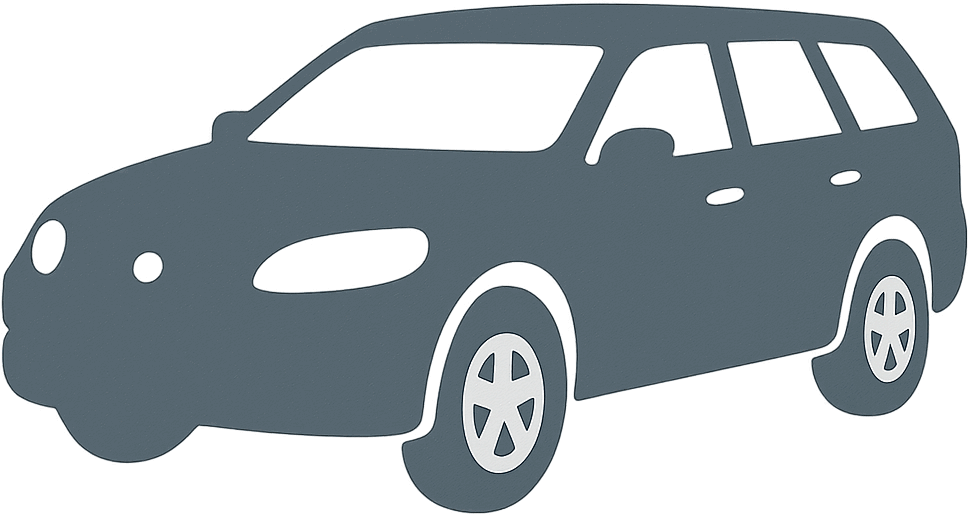 1982 Citroen CX I Break (Phase I, 1982) Dimensions, Size & Specs
1982 Citroen CX I Break (Phase I, 1982) Dimensions, Size & Specs
Measurements of the 1982 Citroen CX I Break, engineered for optimal performance and comfort
| Dimensions | |
|---|---|
| Length: | 4952 mm195.0 in16.2 ft |
| Width: | 1734-1770 mm68.3-69.7 in5.7-5.8 ft |
| Height: | 1456-1465 mm57.3-57.7 in4.8-4.8 ft |
| Trunk Capacity: | 110-1100 liter3.9-38.8 cu ft |
| Trunk Capacity (Max): | 2030 liter71.7 cu ft |
| Weight Specifications | |
| Curb Weight: | 1330-1520 kg2932-3351 lbs |
| Maximal permitted Weight: | 2000-2200 kg4409-4850 lbs |
The Citroen CX I Break (Phase I, 1982) represents a refined iteration of the iconic CX series, built as a practical and spacious station wagon between 1982 and 1985. Designed for families and cargo versatility, this estate blends classic French automotive styling with robust functionality. The CX I Break measures approximately 4950 to 4952 millimeters (195 to 195.1 inches) in length, offering an elongated profile that maximizes interior space. Its width ranges between 1734 and 1770 millimeters (68.3 to 69.7 inches), providing adequate cabin width without compromising maneuverability, while the height varies from 1456 to 1465 millimeters (57.3 to 57.7 inches), creating a balanced stance and good headroom. Weighing in at a curb weight span of 1330 to 1520 kilograms (2932 to 3351 pounds), the CX I Break balances agility with the solid feel expected of a large station wagon. The maximum weight ranges from 2000 to 2200 kilograms (4409 to 4850 pounds), reflecting its capability to carry passengers and cargo efficiently. One of the standout features of the CX I Break is its versatility in luggage capacity. With rear seats upright, it provides 110 liters (3.9 cubic feet) of luggage space, which expands dramatically to 1100 liters (38.8 cubic feet) for everyday hauling needs. When the rear seats are folded down, the available space surges to an impressive 2030 liters (71.7 cubic feet), enabling transportation of bulky items uncommon for estate cars of this era. The CX I Break’s design and dimensions make it an excellent choice for those seeking a combination of classic 1980s European style, spaciousness, and practical utility in a station wagon. It highlights Citroen’s innovative approach to balancing comfort, space, and engineering during the early 1980s.
Discover the standout features that make the 1982 Citroen CX I Break a leader in its class
Have a question? Please check our knowledgebase first.
The Citroen CX I Break (Phase I) from 1982 measures approximately 4950 to 4952 mm (194.9 to 195 inches) in length, making it a notably long station wagon for its time. The width ranges from 1734 to 1770 mm (68.3 to 69.7 inches), providing a spacious cabin and cargo area widthwise, while the height is between 1456 and 1465 mm (57.3 to 57.7 inches), giving it a sleek and aerodynamic profile compared to bulkier wagons. These dimensions combine to offer a well-balanced vehicle footprint, ideal for both urban and highway driving.
The curb weight of the 1982 Citroen CX I Break Phase I ranges between 1330 and 1520 kg (2932 to 3351 lbs), depending on the specific configuration and equipment installed. The maximum permissible weight goes up to 2000 to 2200 kg (4409 to 4850 lbs), meaning the car can handle a significant load, including passengers and cargo. This weight capacity is crucial for station wagons aiming to balance passenger comfort with ample cargo space while maintaining driving dynamics and safety.
The Citroen CX I Break provides a flexible cargo capacity tailored for various needs. With the rear seats up, the luggage capacity is around 110 liters, suitable for everyday groceries and small luggage. When the rear seats are folded down, the space expands dramatically to 2030 liters, accommodating large items such as sports equipment, furniture pieces, or extensive travel luggage. Furthermore, the station wagon's design allows for efficient use of interior space while maintaining a comfortable passenger area.
Yes, the Citroen CX I Break Phase I, with its length close to 4950 mm (195 inches), width up to 1770 mm (69.7 inches), and height below 1465 mm (57.7 inches), generally fits comfortably in a standard residential garage. Most single-car garages have dimensions approximately 2.7 meters (108 inches) wide and 5.5 meters (216 inches) deep, which accommodates the CX I Break with some clearance. However, tight garages might require careful maneuvering due to the station wagon's relatively long length and moderate width.
At 1734 to 1770 mm (68.3 to 69.7 inches) wide, the 1982 Citroen CX I Break has a width that is slightly narrower than many modern station wagons, which commonly exceed 1800 mm (70.9 inches). This narrower width aids maneuverability in urban settings and tight spaces. Despite being more compact widthwise, the CX I Break offers competitive interior space due to its efficient design. The slightly smaller width may appeal to buyers looking for a roomy station wagon that is easier to park and navigate in cramped areas.
The Citroen CX I Break's height ranges from 1456 to 1465 mm (57.3 to 57.7 inches), giving it a low profile relative to many other station wagons. This lower height contributes positively to its aerodynamic efficiency, reducing drag and potentially improving fuel economy and driving stability at speed. Internally, while the height is somewhat lower than taller wagons or SUVs, Citroen's clever use of interior space maximizes passenger comfort, offering ample headroom and a spacious feeling despite the streamlined roofline.
The Citroen CX I Break (Phase I, 1982) measures about 4950 mm in length (approximately 195 inches), which marked an increase compared to its predecessor models, including earlier CX variants or the DS wagon versions. This elongation enhanced cargo space and passenger comfort, providing a more practical station wagon while retaining the distinctive Citroen aerodynamic styling. The added length reflects an evolution aiming to compete more effectively against larger family wagons and estate cars prevalent during the early 1980s.
Compared to other station wagons from 1982, the Citroen CX I Break stands out for its large overall length (4950 mm) and remarkable cargo capacity, especially with the rear seats folded down to 2030 liters. While it may be narrower than some American or German wagons of the era, its luggage volume is highly competitive, often exceeding rivals in practicality. Its low height and aerodynamic shape differentiate it stylistically and functionally, catering to drivers seeking a blend of space-efficient design and advanced suspension comfort, typical of Citroen's engineering approach.
The Citroen CX I Break weighs between 1330 and 1520 kg (2932 to 3351 lbs), with a maximum total weight of 2000 to 2200 kg (4409 to 4850 lbs). Thanks to its pioneering hydropneumatic suspension system, the weight is well distributed, maintaining ride height and balance under varying loads. This distribution aids in minimizing body roll, offering smooth handling and excellent road grip despite the longer wheelbase of a station wagon. The vehicle's design helps preserve the classic Citroen ride quality, making it comfortable on both narrow winding roads and at highway speeds.
The Citroen CX I Break (Phase I) produced from 1982 to 1985 featured distinctive styling consistent with the CX lineup, emphasizing aerodynamic efficiency and comfort. Improvements for this generation included enhanced hydropneumatic suspension for superior ride quality, a spacious and flexible rear cargo area, and modern conveniences not typical in earlier CX models. This Break version catered to families and professionals needing both luxury and utility. Its production marked Citroen's commitment to evolving the station wagon segment with a unique combination of performance, space, and technological innovation.
Discover similar sized cars.

| Production: | 1975-1982 |
|---|---|
| Model Year: | 1976 |
| Length: | 4922-4952 mm193.8-195.0 in |
| Width: | 1734 mm68.3 in |
| Height: | 1456-1465 mm57.3-57.7 in |
